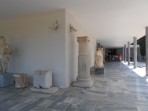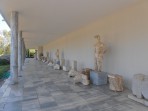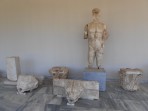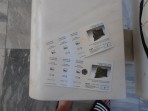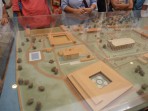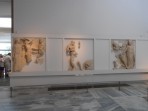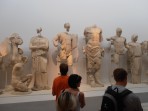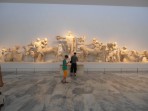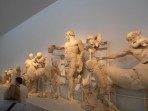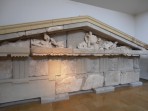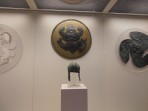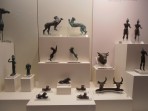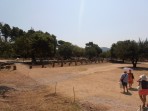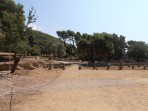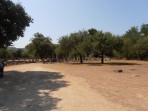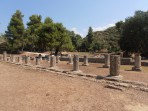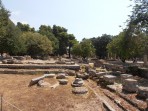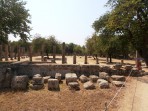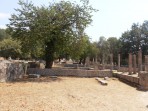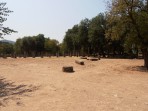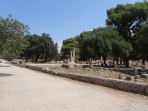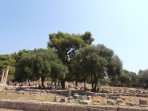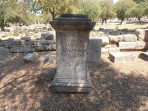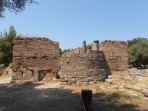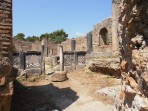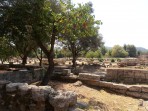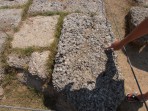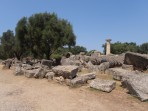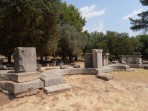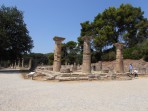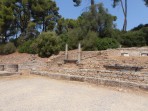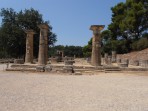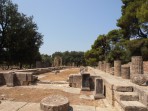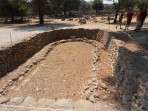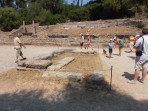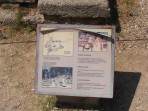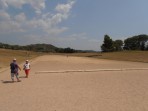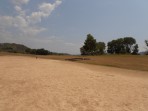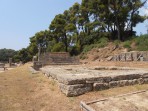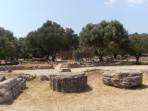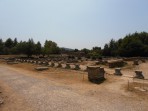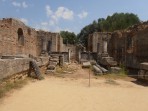Olympia - Tips for trips Zakynthos
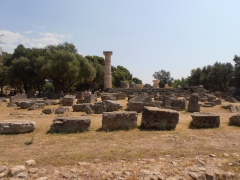
Olympia is one of the most important archaeological sites in Greece and a place that is firmly linked to the tradition of the Olympic Games. The ancient city of Olympia lies in the northwestern part of the Greek Peloponnese peninsula.
Ancient Olympia and the Olympic Games
Ancient Olympia is known as the site of the ancient Olympic Games. The first Olympic Games of which written records survive were held in 776 BC and are considered to be the beginning of the long history of the Olympic Games.
The settlement of the area of Olympia, which takes its name from the seat of the Greek gods, dates back to 2 000 BC, when a sanctuary was built on the site in honour of the god Kronos. The hill overlooking the site was named after the god Kronos. From around the 16th century BC, the cult of Zeus and his consort, the goddess Hera, became prominent in Olympia.
On the basis of the artefacts found here, historians believe that religious festivals in honour of the supreme Greek god Zeus were held as early as around 1000 BC. The first recorded Olympic Games were held in 776 BC, and this year is considered to be the beginning of the Olympic Games and the Greek calendar. The Olympic Games were then held regularly in Olympia every 4 years. However, this originally local affair gradually grew in importance and prestige, and athletes and statesmen from further afield began to flock to Olympia, and the venue had to be adapted to suit.
Initially, the competition was limited to the 1 stadia race and gradually longer distance races were added. This Olympic discipline can be experienced by visitors even today, as the start and finish line (not around the stadium, but in a straight line to the turn-around and back) and the judges' seats have been preserved. In its heyday, the stadium could hold up to 40,000 spectators. The hippodrome, on the other hand, was the venue for horse-drawn carriage races with two-wheeled chariots. Later on, competitions were also held in the discus and javelin, long jump, wrestling and boxing, as well as in pentathlon. As more sports were added, the duration of the games increased to a final 5 to 6 days.
The famous Olympic Stadium was gradually added to by other buildings. Between the 8th and 7th centuries BC, the temple of the goddess Hera, the oldest but best preserved, was built in Olympia. At the same time, training grounds and dormitories were also built, which gradually grew in number as the number of competitors and spectators increased. In the 5th century BC, the temple of the god Zeus was built on the site, which was the largest and represented the centre of the whole of ancient Olympia. The temple was decorated with scenes of ancient history, reliefs and marble statues. In the temple stood a colossal statue of the god Zeus by the Athenian sculptor Feidius. The statue, about 12 metres high, was made of gold, ivory, precious woods and precious stones and was one of the Seven Wonders of the World in its time. Unfortunately, it has not survived to this day.
The Olympic Village also contained a treasury for votive offerings to the gods, and each of the major cities wanted to build their own and then regularly deposited more offerings in it. There were also the Filipeion (a small circular temple dedicated to Philip of Macedon), the Leonidaion (accommodation for selected guests) and the Bouletrion (a hall for the Olympic Council).
The Ancient Olympic Games were the most important Pan-Hellenic (Pan-Greek) Games and were held every 4 years, always about a month after the summer solstice, in honour of the god Zeus. However, the Olympic Games were not only sporting and religious in nature, their great importance also lay in the fact that they strengthened the unity of the Greeks as a nation, which was otherwise divided into different tribes (city states). During the Olympic Games, a sacred truce was observed during which the use of any weapons was forbidden. At the end of the Games, the winner in each event was rewarded with an olive wreath (the olive tree was a gift from the gods and the most sacred plant). The winners of the Olympic Games enjoyed great respect and lifelong veneration in their home country.
End of the Ancient Olympic Games
The famous Olympic Games were held in this spirit for an incredibly long time, more than a thousand years, before they were banned by the Roman Emperor Theodosius I in 394. The official religion of the Roman Empire at the time was Christianity, and the Olympic Games were seen by Christianity as pagan. The Games were still held for some time, but only on a local level.
His successor, the Emperor Theodosius II, issued another edict in 426, reaffirming the ban on the Olympic Games and ordering the destruction of all pagan temples. The pagan deities were replaced by a single Christian God. What was left standing in the Olympic complex after the intervention of Theodosius II was unfortunately destroyed by the numerous earthquakes that are typical of the Ionian Sea area, especially the earthquakes and subsequent floods of 522 and 551.
Archaeological site of Olympia
The first excavations at the site of ancient Olympia were carried out by the Germans in the 1870s and uncovered the remains of Olympic temples and residential buildings. The statues and precious objects found were deposited in the local museum. In 1961, the International Olympic Academy was opened near the eastern side of Kronova Krumlov Hill. In 1989, the archaeological site of Olympia was inscribed on the UNESCO World Heritage List.
Unfortunately, only the foundations or a few columns of most of the Olympic buildings have survived. However, the remains of the ancient buildings have been restored to their best possible condition, the columns have been erected in their original places, and visitors can still walk past the Temple of Zeus and the Temple of Hera, the workshop of Feidius or the Hall of Echoes and enter the Olympic Stadium through the "wrestlers' gate".
We recommend starting your tour of the Olympic complex at the Archaeological Museum, where visitors can get a better idea of the size and grandeur of the whole of ancient Olympia with the help of a well-designed model. The museum also houses some of the most beautiful ancient statues and many rare treasures discovered during excavations in the historic complex. You will also learn interesting facts about the history of the Olympic Games.
In the immediate vicinity of the archaeological site, the smaller town of Ancient Olympia has grown up and has one main street where tourists will find several souvenir shops and hotels.
The tradition of the Olympic Games was revived by a Frenchman named Pierre de Coubertin and the first modern Olympics in Athens in 1896. Nowadays, the Olympic Games are held every four or two years (as the Summer and Winter Olympics alternate every other year) and are still associated with this beautiful place - the Olympic flame, one of the symbols of the Olympic Games, is lit in ancient Olympia and carried from there to the host country of the modern Olympic Games. The flame is lit by the sun's rays through a magnifying glass on the altar of the goddess Hera.
Trip to Olympia
If you decide to take a trip to the famous Olympia from Zakynthos, expect to leave early in the morning and return late in the evening, the journey will take quite a bit of time. You will set sail from the port of the capital of Zakynthos and after about an hour and a half you will dock in the Peloponnese peninsula at the port of Kilini. From there, it's another hour's bus ride to Olympia itself.
If you're going to Olympia as an optional excursion, perhaps your delegate can make your trip shorter and more enjoyable by talking you through the sights of Olympia and Greece as a whole. ;)
More touristic destinations of Zakynthos
Tips for trips on Zakynthos: Zakynthos Capital City, Marathonisi (Turtle Island), Blue Caves, Aristeon Press and Museum, Olympia, Callinico Winery, Water park Zante Water Village (Sarakinado), Shipwreck (Navagio Beach)
Resorts, beaches, sights or trips - clearly listed on the map of Zakynthos.
Did you visit this place and do you have some additional informations, interessting observation or photos?



